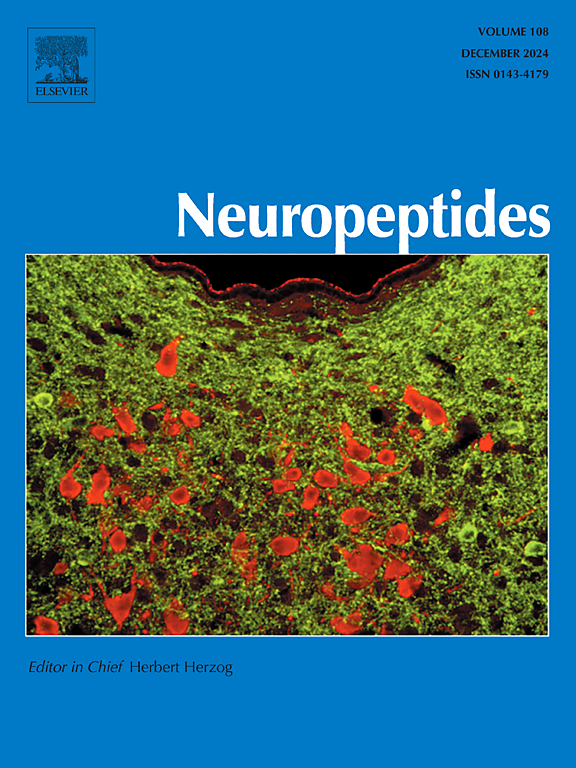神经肽Y通过Y1受体调节小鼠颞氨- ca1突触
IF 2.7
3区 医学
Q3 ENDOCRINOLOGY & METABOLISM
引用次数: 0
摘要
神经肽Y (NPY)是大脑中丰富的神经调节剂,其水平降低与多种神经精神疾病有关,包括创伤后应激障碍(PTSD)。海马CA1区在焦虑调节中起重要作用,并高度表达NPY。在创伤应激模型中,向CA1注射NPY具有抗焦虑和缓解行为症状的作用;这些抗焦虑作用被Y1受体拮抗剂阻断。然而,介导NPY抗焦虑作用的Y1Rs在CA1中的位置尚不清楚。CA1通过颞氨通路(temporamic pathway, TA)接收来自内嗅皮层的输入,这一通路对恐惧学习和应激敏感至关重要。我们的实验室先前表明,NPY减少ta诱发的突触反应,然而,介导这种减少的NPY受体亚型尚不清楚。在这里,我们证明了在小鼠中外源性(浴敷)和内源性释放的NPY在TA通路中通过Y1受体起作用。这是首次证明Y1受体介导的对CA1突触功能的影响。有趣的是,NPY的慢性过度表达(在表达NPY的中间神经元中)会损害ta诱发的突触反应对Y1受体激动剂的敏感性。然而,众所周知的NPY Y2受体介导的Schaffer侧枝通路的作用不受NPY过表达的影响。因此,NPY可以通过NPY受体的差异表达及其对NPY过表达的反应对CA1突触传递产生通路特异性影响。我们的研究结果表明,NPY在TA通路中作用于Y1受体,这与TA通路是NPY在CA1中抗焦虑作用的基础的观点是一致的。本文章由计算机程序翻译,如有差异,请以英文原文为准。
Modulation of temporoammonic-CA1 synapses by neuropeptide Y is through Y1 receptors in mice
Reduced levels of neuropeptide Y (NPY), an abundant neuromodulator in the brain, are linked to multiple neuropsychiatric disorders, including post-traumatic stress disorder (PTSD). The CA1 region of hippocampus is important for anxiety regulation and highly expresses NPY. Injecting NPY into CA1 is anxiolytic and alleviates behavioral symptoms in a model of traumatic stress; these anxiolytic effects are blocked by a Y1 receptor antagonist. However the location of Y1Rs that mediate NPY's anxiolytic effects in CA1 remains unclear. CA1 receives inputs from entorhinal cortex through the temporammonic pathway (TA), which is important for fear learning and sensitive to stress. Our lab previously showed that NPY reduces TA-evoked synaptic responses, however, the subtype of NPY receptor mediating this reduction is unknown. Here we demonstrate that in mice both exogenous (bath-applied) and endogenously-released NPY act through Y1 receptors in the TA pathway. This is the first demonstration of Y1 receptor-mediated effect on synaptic function in CA1. Interestingly, chronic overexpression of NPY (in NPY-expressing interneurons) impairs the sensitivity of the TA-evoked synaptic response to a Y1 receptor agonist. However, the long-known NPY Y2 receptor-mediated effect on the Schaffer collateral (SC) pathway is unaffected by NPY overexpression. Therefore, NPY can have a pathway-specific impact on synaptic transmission in CA1 based on the differential expression of NPY receptors and their response to overexpression of NPY. Our results demonstrating that NPY acts at Y1 receptors in the TA pathway are consistent with the idea that the TA pathway underlies the anxiolytic effects of NPY in CA1.
求助全文
通过发布文献求助,成功后即可免费获取论文全文。
去求助
来源期刊

Neuropeptides
医学-内分泌学与代谢
CiteScore
5.40
自引率
6.90%
发文量
55
审稿时长
>12 weeks
期刊介绍:
The aim of Neuropeptides is the rapid publication of original research and review articles, dealing with the structure, distribution, actions and functions of peptides in the central and peripheral nervous systems. The explosion of research activity in this field has led to the identification of numerous naturally occurring endogenous peptides which act as neurotransmitters, neuromodulators, or trophic factors, to mediate nervous system functions. Increasing numbers of non-peptide ligands of neuropeptide receptors have been developed, which act as agonists or antagonists in peptidergic systems.
The journal provides a unique opportunity of integrating the many disciplines involved in all neuropeptide research. The journal publishes articles on all aspects of the neuropeptide field, with particular emphasis on gene regulation of peptide expression, peptide receptor subtypes, transgenic and knockout mice with mutations in genes for neuropeptides and peptide receptors, neuroanatomy, physiology, behaviour, neurotrophic factors, preclinical drug evaluation, clinical studies, and clinical trials.
 求助内容:
求助内容: 应助结果提醒方式:
应助结果提醒方式:


